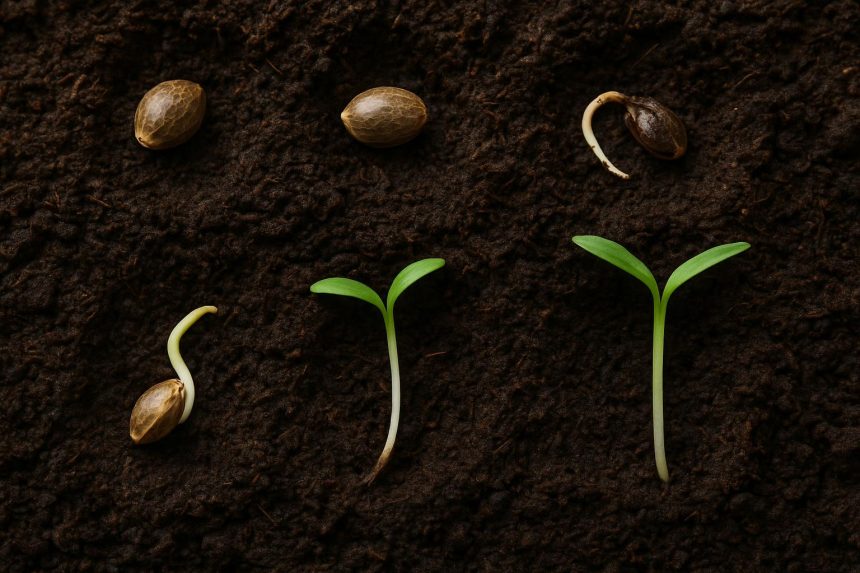Introduction: The Frustration of Low Germination
The inability of a high-quality seed to sprout is a major source of frustration for growers at every skill level. When you invest time, money, and hope into a pack of genetics, seeing a germination rate fall below 80% is disheartening. It often signals a fundamental issue in your process. Achieving successful germination (the process where a dormant seed comes alive) shouldn’t feel like a coin flip. With a few simple adjustments and a deeper understanding of a seed’s needs, you can easily push your success rate toward the high nineties. This article breaks down the four most common culprits responsible for poor germination and how to fix them.
1. Temperature Trauma: Too Hot, Too Cold, or Too Wild
Temperature is arguably the single most important factor, yet it is often the most overlooked. Seeds are sensitive biological packages; they need a stable, warm environment to signal that it is safe to start growing.
The Ideal Range
The sweet spot for most seeds, including Cannabis seeds, lies between 72 degrees to 78 degrees Fahrenheit. Fluctuations are the enemy. A seed that bounces between 60 degrees to 80 degrees Fahrenheit throughout the day is under immense stress. This thermal stress can significantly disrupt or even stop the seed’s metabolic activities, potentially resulting in fungal contamination (discussed later) or total non-germination.
The Fix
To ensure temperature stability, use a heated propagation mat. These inexpensive mats provide consistent bottom heat. If using the paper towel method, place the container on the mat, and ideally, cover the entire setup with a humidity dome (or a clear, upside-down container) to stabilize the air temperature around the seeds as well. Always use a reliable thermometer to monitor the actual temperature at the seed level, not just the room temperature.
2. Moisture Mismanagement: Drowning or Drying Out
The second major factor is water, and it’s a tightrope walk. Seeds need moisture to soften their shells and activate the hormones that trigger growth.1 However, too much water is as deadly as too little.
The Dangers of Overwatering
When you soak a seed in standing water for too long (beyond 24 to 36 hours), you essentially cut off its oxygen supply. Seeds, like all living organisms, respire, which means they need to breathe. Waterlogging leads to anaerobic conditions (no oxygen) that quickly kill the embryo. This is the main reason why simply dropping Cannabis seeds into a glass of water often fails if left too long.
The Fix
If you are using a growing medium (like soil or rockwool), it should be damp, like a wrung-out sponge (not dripping wet). If you are using the popular paper towel method, the towels should be misted with water, not saturated. A simple trick is to gently squeeze the paper towels before placing the seeds (just like wringing out that sponge). They should feel moist, and you should be able to see a slight sheen of water, but no water should pool when the towels are flat.
3. The Depth Dilemma: Planting Too Deep
Once you transition the germinated seed or the unsprouted seed directly into a medium, planting depth becomes critical. Many new growers, out of a misguided desire to protect the seed, bury it too far down.
The Struggles of the Sprout
The tiny root (radicle) and the shoot must have enough stored energy to push through the medium and reach the surface. Every millimeter of soil resistance drains that energy. If a seed is planted deeper than half an inch (about 12 millimeters), the emerging shoot may exhaust its reserves before it ever sees the light of day. This is particularly true for older or less vigorous seeds.
The Fix
The ideal planting depth is shallow (less than half an inch). A good rule of thumb is to bury the seed no deeper than twice its size. For maximum ease of emergence, try placing the seed right on the pre-moistened surface and lightly sprinkling a thin layer of soil or coco coir over it. The covering material must be fluffy (not packed down) so the fragile sprout meets minimal resistance.
4. Media and Fungal Attacks: The Invisible Killers
Perfect climate control doesn’t guarantee success; a non-sterile or nutrient-heavy medium can shelter harmful pathogens that quickly destroy the delicate taproot. These aggressive fungal and bacterial attacks are the primary cause of “damping off,” a well-known affliction where a thriving young plant suddenly collapses precisely at the point where it emerges from the soil.
The Threat of Mold and Bacteria
If you are reusing soil or using unsterilized peat pellets, you introduce the risk of mold spores or harmful bacteria. These organisms thrive in the exact warm, damp conditions ideal for germination. They often manifest as a fuzzy white or grey growth that attacks the soft, tender root or stem of the new plant.
The Fix
Always use a fresh, sterile starting medium. If using soil, purchase a dedicated “seed starting mix” (which is lighter and more sterile than general potting soil). If you are using rockwool or coco coir, sterilize them with a quick dip in a weak solution of hydrogen peroxide (about one part 3% peroxide to three parts water) before planting. This cleans the medium and also adds an extra boost of oxygen for the emerging root. By addressing these four core issues—stability of temperature, precision in moisture, proper depth, and media cleanliness—you will undoubtedly see your success rate with Cannabis seeds climb well over the 80% mark, leading to a much smoother start for your entire grow.
Lynn Martelli is an editor at Readability. She received her MFA in Creative Writing from Antioch University and has worked as an editor for over 10 years. Lynn has edited a wide variety of books, including fiction, non-fiction, memoirs, and more. In her free time, Lynn enjoys reading, writing, and spending time with her family and friends.















